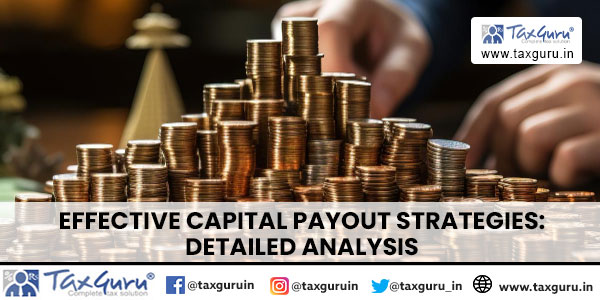Providing a beneficial payouts to the equity holders is always expected by the equity owners and to do it perfectly is always expected by the equity issuers. Effectively managing the gap between equity issuers and the equity owners has always been a challenge. Equity issuers always seek funding assistance from the equity owners for various purposes. In turn, even after analyzing the various purposes for which the equity owners fund the equity issuers, the payouts should be beneficial to the equity owners for them to feel secured in the economic aspect.
Even though, raising capital through equity issue is the most secured way of raising funds, practically the equity owners are facing huge risk in recovering their investments back. This trend in the market would lead to huge consequences driving the equity owners to avoid risks in the investment. This wouldn’t be the case anymore, if equity owners are assured with a proper and effective payout plan. And to frame such effective plans, we have to oversee certain strategies.
There are various methods of planning capital payouts (inter-alia);
- Payment of Dividend
- Buy-Back of Equity
- Reduction of Share Capital
Let us discuss in brief the above specified methods in detail.
1. Payment of Dividend;
a. This can be helpful for periodic payouts. Therefore, if the intention of the equity owner is to get periodic returns, the payout plan must ensure payouts through dividends.
b. By adopting this method, the benefits of Debt can be provided for the equity owners. The main advantage for the debt owners are receipt of periodic interest at fixed rate ensuring constant return. By breaking the convention that equity owners could not get a constant return for their investment, the Equity purchase agreements can have dividend clause which will ensure constant payouts for the equity owners.
c. The tax on dividend received in the hands of the equity owner is taxed on normal tax rate applicable to the assesse.
| Merits | Demerits |
| Beneficial to the investors as it ensures periodic returns to the Investors. | The Fund seeker has to be very liquid in order to ensure constant payouts to the Investor. |
| Equity is effectively and efficiently used as a Debt. | Dividend payment cannot be claimed as an expense. |
| Investors are kept happy since they are instantly rewarded for their risk. | May be applicable only to profit making companies. Board has to meet often. |
2. Buy-Back of Equity;
a. This method of payout is the most tax efficient method that every equity owner would dream to reap the benefit.
b. This method of capital payout is the most tax efficient method as the tax liability of the equity owner would be “zero”.
c. Provided proper planning, this method can also be used as a substitute for the first method and can be used as an alternative for the first method by enabling a “periodic buy back clause” in the equity purchase agreements.
d. In this method, the equity issuer has to properly asses the tax outcomes out of this arrangements as the equity issuer is subject to tax.
e. The tax rate for the distributed income (i.e., the buyback amount) is set at 20%, along with a 12% surcharge and applicable cess.
| Merit | Demerit |
| The most tax efficient return of investment alternative for an Investor. | The entire of the investment of the investor cannot be bought back exceeding prescribed limits. |
| May be helpful for listed entities to regulate the volatility of market price. | Restrictions exists in further issue of equity post buy back. |
3. Reduction of Capital;
a. This method of payout is generally a “one time” in the entire tenor of investment. This method is a court administered process.
b. This method of payout with consideration is generally advised when the equity owner wishes capital payout after a defined time frame.
c. The surplus received over and above the accumulated profits by the Equity owner is generally classified as “Capital Gains” and taxed accordingly. The consideration received at par with the accumulated profits is treated as “Deemed Dividend” and taxed accordingly.

d. There is no tax liability for the equity issuer in this arrangement. But, almost all aspects of this method from merit view point is outweighed by “Buy Back”. Therefore, planning capital payouts only with this method is now an old fashion.
e. But this method of capital pay out cannot be totally avoided, rather, it can be combined with any other method for better benefits.
| Can be a tax efficient payout method if properly planned. | This is not a self-administered payout method. It has to have blessings of NCLT, which may cause a delay to the return of investment. |
| There are no upper limits to return the capital. | Slightly costlier process as many professional are involved. |
COMBINED STRTAEGY FOR EFFECTIVE OUTCOME
It is not a rule of land that only either of the above methods could be pursued to plan capital payouts individually. In accordance to the facts and circumstances, any of the methods can be combined to plan the pay outs.
1. “Equity linked Debt Investment – with compulsory pay back of capital”
This strategy combines the benefits of “equity” along with “debt” which ensures periodic return throughout the tenor of the investment with compulsory reduction of equity stocks at the end of the tenor.
The main advantage of “Equity” is holding administrative rights (inter-alia) and the main advantage of “Debt” is periodic return (inter-alia). This method primarily focuses on linking these both advantages by planning issue of equity with promised returns.
One may even think of holding debt with an option to convert into equity as and when there are defaults in repayments or for any other possible reasons as the case may be. In that case, the debt owner would periodically receive a return as “interest” and an option to exercise his right and get the equity if situation warrant so. But the main disadvantage of this arrangement is the overvaluation of equity. Generally assuming that, the equity issuer is carrying over business and plans for expansion and seeks for financial assistance, the value of the equity issuer would be slightly lower than the value it could achieve over the tenor of investment, which might enable the equity owners to entitle slightly more number of equity shares.
For eg; If ABC Pvt Ltd seeks Rs. 10,00,000 to fund its project. Now, if “X” is ready to fund the project at 10% return expectation.
a. Debt with option to convert to equity shares;
Assumptions;
The tenor of the investment is 12 months.
Ab-initio the value per equity share is Rs. 15.
After undertaking the project, the value per equity share becomes Rs. 25 per equity share.
Facts;
Now if X funds the project through Debt with option of conversion and at the end of tenor, if situation warrants so to make think X to exercise his conversion right, X could be entitled less number of shares than he would have had if he funded the project through equity.
Conclusion;
Therefore, by enabling a clause to get entitled for periodic dividend payouts to achieve return of 8% on the funds advanced, we could achieve periodic returns.
Also, by enabling a clause to obligate the fund seeker to compulsorily reduction of the actual funds financed through equity, we could achieve recovery of principal over a tenor.
One last interesting aspect;
For SPV involved in specific projects which may be midterm or long term, generally debt funding is preferred at larger aspect with equity kept at minimum level. If for SPVs involved in specific projects which may be midterm or long term, equity investments are planned, the equity investors would generally demand a clause in Shareholders Agreement for a constant dividend clause or for a structure pay out plan. Generally, for projects which wouldn’t generate instant returns, the investors who cannot expect monetary returns would like to reserve administrative rights for the said period where there wouldn’t be any returns. Ideally, administrative rights are not an objective for the investors who are just interested in monetary gains. They just do it for a time being to protect their interests as an investor. Once, if the project starts to get inflows, the only aim the investor is to take out his portion with premium for his risk. At that point of time the investor does not hold interest in administrative rights but is only focusing on constant return of investment.
At that point of time, to ensure constant returns the equity shares can be converted into preference shares to ensure constant payouts in a most efficient manner without administrative rights.
It has been a debate always when the conversion is other ways round, i.e from equity to preference. It is settled that the vice versa is conveniently viable without any intervention of NCLT or Courts, if it is issued with options to convert.
Now, this conversion of equity into preference is also slowly getting settled by way of evolving robust corporate finance requirements. As recently, The Hon’ble National Company Law Tribunal, Mumbai Bench (“NCLT”) vide an order dated 20 September 2021, approved the Scheme of Arrangement and Amalgamation proposed by Protrans Supply Chain Management Private Limited under sections 230 to 232 of the Companies Act, 2013 (“Scheme”). The Scheme provided amalgamation of entities and conversion of equity shares into preference shares. The rationale for the latter issue was that the small shareholders of the transferee company (approximately 21,000 out of 21,675 shareholders, in number) were requesting for regular dividends on their investments. In view of these facts, it was proposed as an integral part of the Scheme to alter the shareholding structure of the company by conversion of certain A class Equity Shares into 9% non-cumulative optionally convertible redeemable Preference Shares of INR 10 each (“Conversion Exercise”).
The Regional Director, Ministry of Corporate Affairs by his report (“Regional Director’s Report”) objected to inter-alia, the Conversion Exercise basis the report of the Registrar of Companies.
But, finally the Hon’ble NCLT, Mumbai approved the scheme and also allowed the conversion of equity into preference shares.
Having said whatsoever in the above note, it is essentially becoming the need of hour to shift from the conventional option to just plan finance with one option. Making the structure of finance more diverse along with an attractive plan to the investors with an assured benchmark return, the way we grow.
*****
“Disclaimer: The information presented in this article is intended for informational purposes only and should not be construed as professional advice or opinions. The content is based on research and factual information available at the time of writing. Readers are encouraged to independently verify the accuracy and applicability of the information to their specific circumstances. The author and publisher do not assume any responsibility for errors, omissions, or consequences resulting from the use of the information provided herein. Any reliance on the information contained in this article is at the reader’s own risk.”
This clause helps clarify that the article is based on factual information and research rather than personal opinions or professional advice, and it encourages readers to verify the information and make their own decisions based on it.





